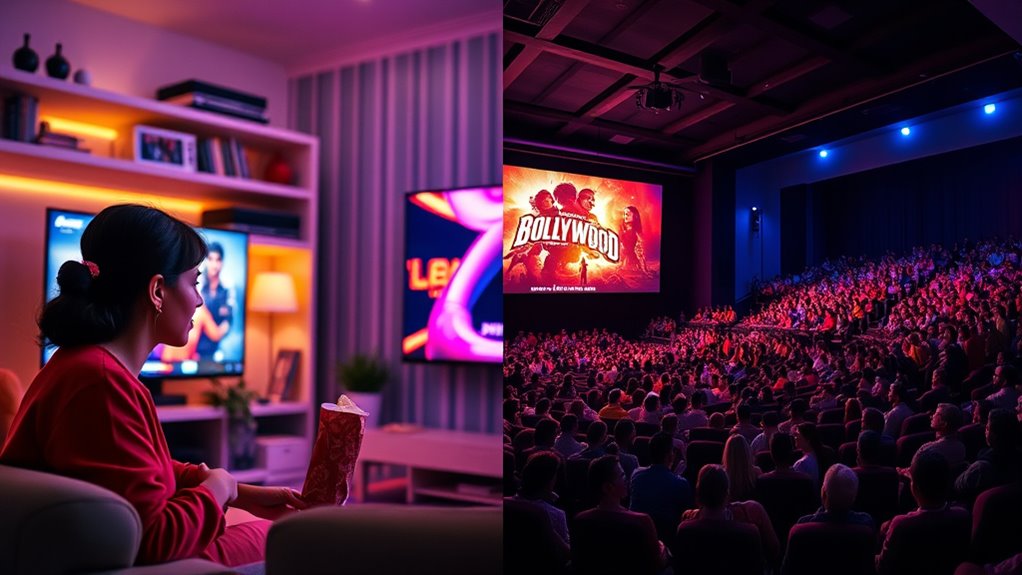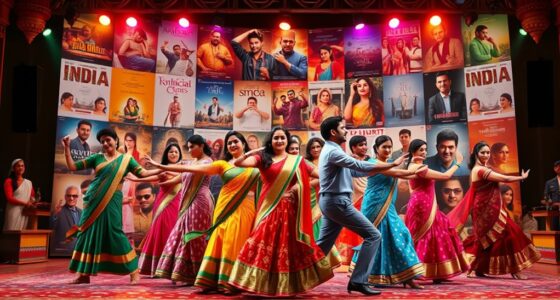Streaming platforms are transforming Bollywood by shifting audiences from traditional cinemas to on-demand content, impacting box office numbers. With faster release windows, hybrid models, and increasing original content, OTT provides a wider variety of genres and regional options that keep viewers engaged at home. This shifts revenue from theaters to digital rights and subscriptions. If you continue, you’ll discover how this change is shaping Bollywood’s future and redefining success.
Key Takeaways
- OTT platforms prioritize digital rights sales and early releases, reducing reliance on traditional theatrical box office revenue.
- Hybrid release strategies and shorter theatrical windows shift audience focus from cinemas to OTT viewing.
- The decline in theater footfall impacts box office earnings, prompting filmmakers to target OTT as a primary distribution channel.
- OTT originals and regional content broaden audience engagement, decreasing dependence on blockbuster theatrical hits.
- Streaming platforms’ personalized recommendations and interactive features boost viewer retention, challenging cinema’s traditional appeal.
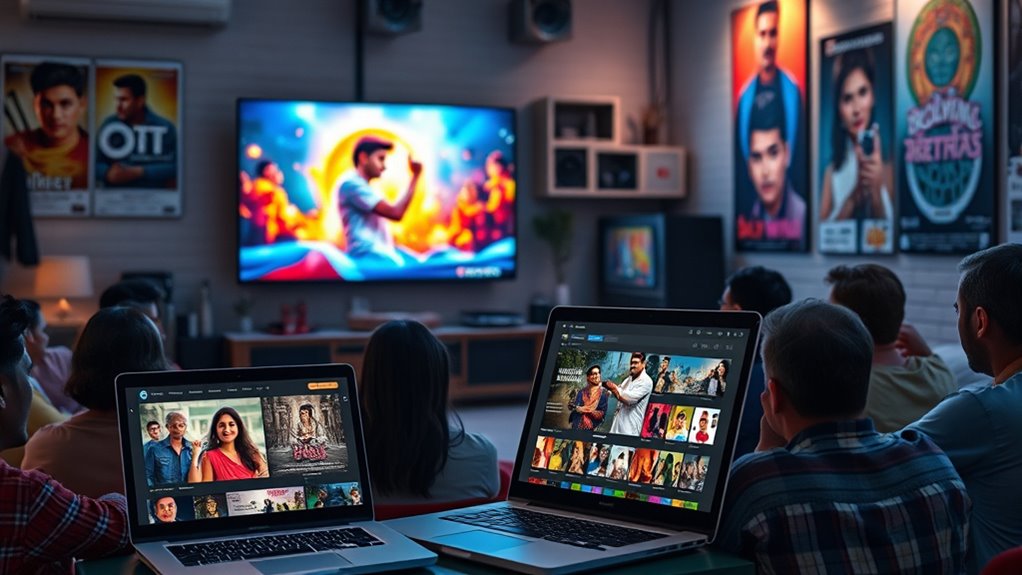
The rise of OTT platforms has considerably transformed the entertainment landscape, leading to a notable shift in audience preferences and market dynamics. You’re likely noticing how platforms like Amazon Prime Video, Hotstar, and others now command significant market shares, with Amazon expected to hold around 18% by 2024. This competition is fragmenting the market, as more players enter and diversify content offerings. As a viewer, you now have access to a vast array of regional and on-demand content, making it easier to watch what you want, when you want it. This shift is driven by increased internet access, affordable data plans, and the proliferation of mobile devices. Consequently, traditional cinema attendance is declining, while OTT consumption continues to grow rapidly, reshaping how audiences engage with entertainment. Market growth projections indicate that the OTT market in India is expected to reach USD 3.21 billion by 2030, further emphasizing the ongoing transition from traditional cinemas to digital streaming. Additionally, the content variety available on these platforms caters to diverse tastes, further accelerating viewer migration from cinemas.
Changing Release Windows and Strategies

As OTT platforms gain popularity, filmmakers and producers are increasingly adjusting their release strategies to stay competitive. They’re moving toward early OTT premieres, sometimes within weeks of theatrical releases, like *Bhool Chuk Maaf*. Many films skip traditional theaters altogether, opting for direct-to-OTT launches to cut costs and reach wider audiences. This shift has sparked legal disputes with theater chains, as seen with *Bhool Chuk Maaf*, and prompted rescheduling based on market conditions. Some films even pursue simultaneous theatrical and OTT releases, though less often in India. These changes influence production budgets, timelines, and market sensitivity. Additionally, monitoring market trends and insights is crucial for strategic planning. The adoption of suitable release strategies reflects a broader industry response to evolving viewer preferences and technological advancements. As the industry adapts, regulatory considerations also come into play to address the legal implications of new release windows. Moreover, the audience reception to these new strategies significantly impacts future distribution models. Industry stakeholders are also leveraging AI analytics to better understand viewer behavior and optimize release timings. Here’s a quick look at the evolving strategies:
| Strategy | Impact |
|---|---|
| Early OTT Premieres | Faster audience engagement, legal issues |
| Direct-to-OTT Releases | Cost savings, market expansion |
| Rescheduling Releases | Adaptability to geopolitical trends |
| Hybrid Releases | Broader reach, increased competition |
Audience Preferences: From Theatrics to On-Demand Content

With the rise of OTT platforms, audiences now favor on-demand content over traditional theatrical experiences, especially among younger viewers. You’ll find that 57% of 18-29-year-olds prefer watching new films on streaming platforms, often using smart TVs or set-top boxes—78% of viewers do so. Comedy is the most popular genre on OTT, with 55% enjoying it on these platforms, while only 19% prefer theatres. Notably, 26% of people watch films in both settings, but those over 40 tend to stick with TV or theatres. Although theatres are seeing a post-pandemic increase among young adults, OTT’s convenience, variety, and genre diversity continue to reshape how you consume movies. This shift highlights evolving preferences, with on-demand content becoming the new norm for many audiences. Streaming’s dominance over cinema attendance is evident, especially as cost concerns and home viewing habits influence consumer choices.
OTT Originals and Their Impact on Viewer Engagement
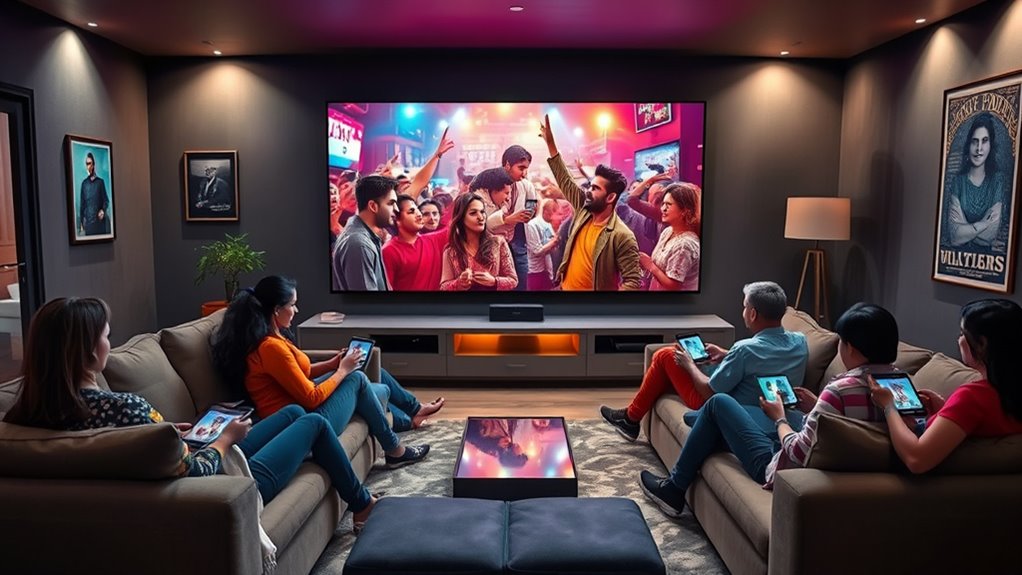
OTT originals are transforming how you engage with content, thanks to impressive viewer metrics and innovative storytelling. With more diverse genres and high production values, platforms keep your attention through fresh, original material. This shift not only boosts viewer loyalty but also challenges traditional cinema experiences. India’s OTT market revenue in 2024 is projected at $4.06 billion, reflecting the rapid growth and increasing investment in original programming. The rise of high-quality production standards has further elevated the appeal of OTT content over conventional cinema.
Viewer Engagement Metrics
Have you ever wondered how platforms measure the success of their original content? They primarily look at viewer engagement metrics like watch time, which shows how long you stay hooked. Drop-off points reveal where you lose interest, helping creators improve content. Interaction rates, such as likes, comments, and shares, indicate how much you connect with the material. Digital influence plays a role too—users engaged online tend to watch longer, boosting overall engagement. The content format matters as well as mindfulness techniques; series and movies impact your viewing differently. High viewership records for shows like *Squid Game 2* demonstrate how compelling content draws large audiences. These metrics give platforms a clear picture of what resonates, guiding future content that keeps you engaged and coming back for more. Additionally, understanding your Beach Body goals can motivate creators to develop content that aligns with viewer interests and preferences. Recognizing the importance of viewing hours can help content creators tailor their releases to maximize engagement, especially when integrating nutrient-rich ingredients to boost content appeal and viewer retention. Furthermore, incorporating diverse training techniques in content development can enhance viewer satisfaction and loyalty.
Content Diversity Expansion
The expansion of content genres on streaming platforms has considerably boosted viewer engagement by offering a wider variety of stories that cater to diverse tastes. You now have access to Indian originals across genres like drama, thriller, romance, and crime, often presented through web series with complex, multi-episode narratives that keep you hooked. Popular titles like “Sacred Games,” “Mirzapur,” and “Special Ops” showcase this genre diversity and attract global audiences. Regional language content further broadens options, reflecting India’s cultural diversity and attracting viewers from different states. This variety keeps you engaged longer, with many spending around 180 minutes daily on OTT platforms. The availability of niche, innovative stories encourages binge-watching and appeals to younger audiences seeking fresh entertainment that moves beyond traditional Bollywood fare. Additionally, the rise of OTT Originals has led to increased investment in high-quality, exclusive content, further enhancing viewer loyalty and platform differentiation. The focus on content diversity has also contributed to the development of more nuanced storytelling techniques and production values, elevating the overall quality of digital entertainment. Moreover, the integration of content personalization techniques helps platforms recommend tailored content, increasing viewer satisfaction and retention. A growing trend is the incorporation of regional language content, which broadens the scope of storytelling and makes digital entertainment more inclusive.
Originality and Innovation
Original storytelling on streaming platforms has revolutionized viewer engagement by producing highly rated shows like “The Family Man” and “Scam 1992,” which captivate audiences with fresh narratives. OTT originals often explore innovative genres, such as “Paatal Lok,” blending crime and mythology to keep content exciting. They also focus increasingly on regional languages, broadening reach beyond Hindi. International hits like “Squid Game 2” attract millions of Indian viewers, boosting global appeal. OTT platforms are pushing creative boundaries, investing heavily in high-quality visuals, advanced technology like 4K and Dolby Atmos, and forging collaborations that enhance content. This innovation fosters new talent opportunities and influences Bollywood’s experimental trends. As a result, viewer engagement deepens through longer, personalized, and diverse stories, making OTT a game-changer in entertainment. The streaming ecosystem’s rapid evolution also means content is now tailored to diverse audience preferences, ensuring sustained viewer interest. Additionally, the use of AI-driven analytics helps platforms identify emerging trends and optimize content strategies to maximize engagement and retention, further reinforcing the importance of AI Security in maintaining content integrity and safeguarding viewer data.
Comparing Box Office Success and Streaming Performance
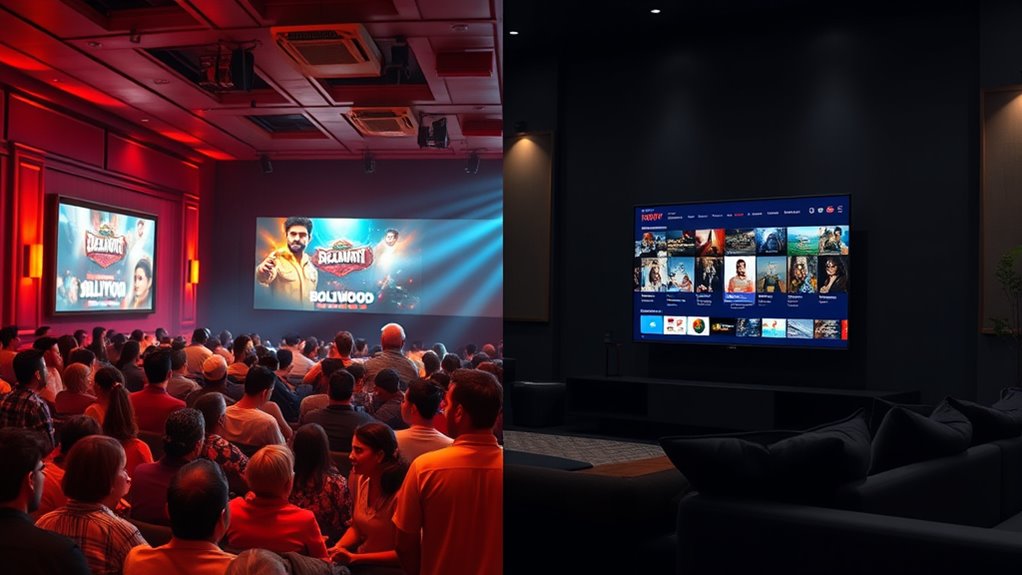
You’ll notice that box office revenue and streaming performance tell different stories about audience engagement. While theaters generate high upfront earnings, streaming platforms often focus on long-term digital rights and subscriptions. These contrasting strategies highlight how revenue discrepancies and release tactics shape each medium’s success. Additionally, the evolving consumption of home decor accessories reflects a shift toward personalized and accessible wellness solutions, much like how OTT platforms are customizing content to suit diverse viewer preferences. The rise of content remapping and targeted programming further exemplifies this shift in viewer engagement strategies, emphasizing the importance of understanding individual personality traits to optimize content delivery and audience retention.
Revenue Discrepancies Highlighted
While box office revenue remains a crucial indicator of cinematic success, streaming platforms are reshaping the industry’s revenue landscape. In India, the box office is projected to reach $2.45 billion by 2025, but recent trends show a 4% decline in 2024. The total gross collection in 2024 was Rs 11,833 crore, with 110 films releasing and each earning over Rs 10 crore. Hindi films now account for just 40% of revenue, down from 44%. Meanwhile, streaming content dropped to 315 titles in 2024, the lowest since 2020, yet its influence continues to grow. Despite fewer titles, streaming platforms shape audience preferences, creating a revenue gap between traditional cinema and digital consumption. This discrepancy underscores the shifting priorities in Bollywood’s revenue streams.
Audience Engagement Differences
Have you ever wondered how audience engagement differs between box office hits and streaming successes? Box office success is measured through opening day earnings and 100-crore benchmarks, while streaming relies on hours watched and subscriber growth—metrics often kept secret. Theatrical releases generate organic buzz through marketing campaigns spanning weeks, building anticipation and deepening audience connections. On streaming platforms, star power and tailored content maintain high engagement, but overall viewership for direct-to-streaming films tends to be lower.
| Engagement Metric | Box Office | Streaming |
|---|---|---|
| Audience Buzz | High pre- and post-release | Varies; star-driven content |
| Viewership Patterns | Organic, sustained | Personalized, data-driven |
| Marketing Duration | 4–8 weeks pre-release | Continuous, adaptive |
Release Strategies Diverge
Release strategies for movies now vary considerably between traditional box office approaches and streaming platforms, shaping how films reach audiences and generate revenue. OTT platforms often enable simultaneous global releases, expanding reach instantly, while cinema releases tend to be staggered internationally, focusing on initial box office bursts. Exclusive theatrical runs can boost ticket sales, but OTT reduces marketing costs and allows some films to succeed through direct digital releases. Box office success is mainly gauged by gross earnings and opening weekend performance, influenced by hype and reviews. In contrast, streaming success hinges on viewership data and engagement metrics, with platforms offering detailed analytics. Some films benefit from hybrid releases, combining theatrical and OTT strategies, diversifying revenue streams and reducing financial risks. Visionary quotes can inspire filmmakers and marketers to adopt innovative release strategies that challenge traditional norms.
The Role of Regional and Global Content in Shaping Trends
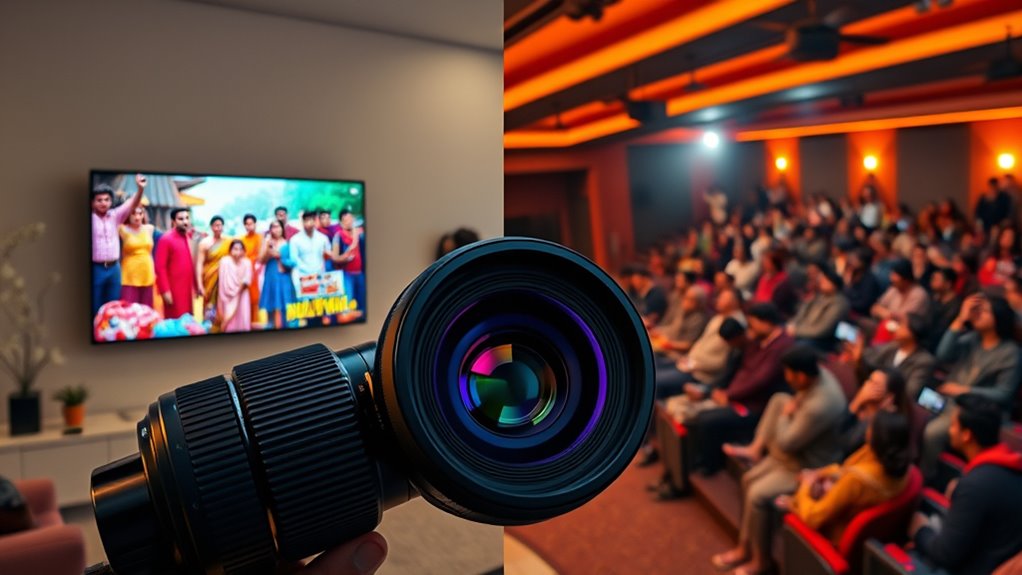
Regional and global content play a crucial role in shaping current streaming and cinema trends by influencing audience preferences and industry practices. You’re now seeing OTT platforms offering diverse regional films, appealing to audiences seeking culturally rich stories. With around 1,800 to 2,000 regional films produced annually, these movies are gaining popularity and crossing over into mainstream success, like *Pushpa: The Rule – Part 2*. This regional influence is prompting Bollywood to adapt, incorporating regional narratives and talent. Meanwhile, global content on OTT platforms exposes viewers to international series and films, inspiring Bollywood’s storytelling and pushing it to innovate. The rising global OTT market, partnerships, and audience demand for international content are driving Bollywood to compete on a global scale, shaping the future of Indian cinema.
Impact of OTT on Bollywood’s Traditional Revenue Streams

You’re likely noticing how OTT platforms are shifting revenue patterns, with more viewers choosing online content over theaters. This change impacts box office earnings and forces filmmakers to rethink how they generate income. As audience engagement moves online, traditional revenue streams for Bollywood face significant challenges.
Revenue Shift Patterns
The rise of OTT platforms has fundamentally altered Bollywood’s revenue landscape by shifting the focus away from traditional theatrical earnings. You’ll notice a decline in box office revenue, with 2025 Hindi collections around ₹1,422 crores and overseas just ₹278 crores. Fewer films hit blockbuster status, and many struggle to recover costs from theatrical runs. Meanwhile, OTT platforms have surged, offering lucrative deals that cover production costs and reduce financial risks. Studios now prioritize OTT rights early and release films directly on streaming services. This shift is reflected in shorter theatrical windows and hybrid releases, with digital rights often surpassing box office income. Below is a visual summary:
| Traditional Revenue | OTT-Driven Revenue |
|---|---|
| Box office earnings | Streaming subscriptions |
| Theatrical window | Early digital rights sales |
| Franchise focus | Original OTT content |
| Risk primarily on theaters | Risk shared with OTT platforms |
Audience Engagement Changes
As OTT platforms become the primary way audiences access movies, traditional viewing habits are rapidly shifting. You now prefer streaming for star-studded films, with 67% favoring OTT releases for popular actors, and 66% choosing OTT for new actors’ movies. Regional and Hindi films are also more accessible on streaming, with 58% and 52% favoring OTT over theaters. Urban audiences appreciate the convenience and flexibility, while younger viewers binge-watch and access content across devices. Traditional TV has declined, with 69.6% watching only 0–2 hours weekly. Personalized recommendations, interactive features, and social media integrations boost engagement. This transformation fosters deeper audience involvement, changing how you discover, discuss, and consume films, ultimately reshaping Bollywood’s entertainment landscape.
Box Office Decline
The COVID-19 pandemic accelerated the decline of Bollywood’s traditional box office revenues by forcing cinema closures and deterring audiences from visiting theaters. As a result, box office collections plummeted, with Rs 50 crore becoming the new success benchmark instead of Rs 100 crore pre-pandemic. Hindi cinema’s revenue dropped from Rs 6,600 crore in 2023 to Rs 5,000 crore in 2024. High-budget films struggled to turn a profit despite crossing Rs 100 crore, highlighting diminishing returns. The decline in theater footfall directly impacted revenue streams that once fueled Bollywood’s growth. Meanwhile, OTT platforms gained prominence, diverting audiences and changing how films are monetized. This shift has created a challenging environment for traditional theatrical success, forcing producers to rethink release strategies.
The Future of Cinema: Integrating Streaming and Theatrical Releases
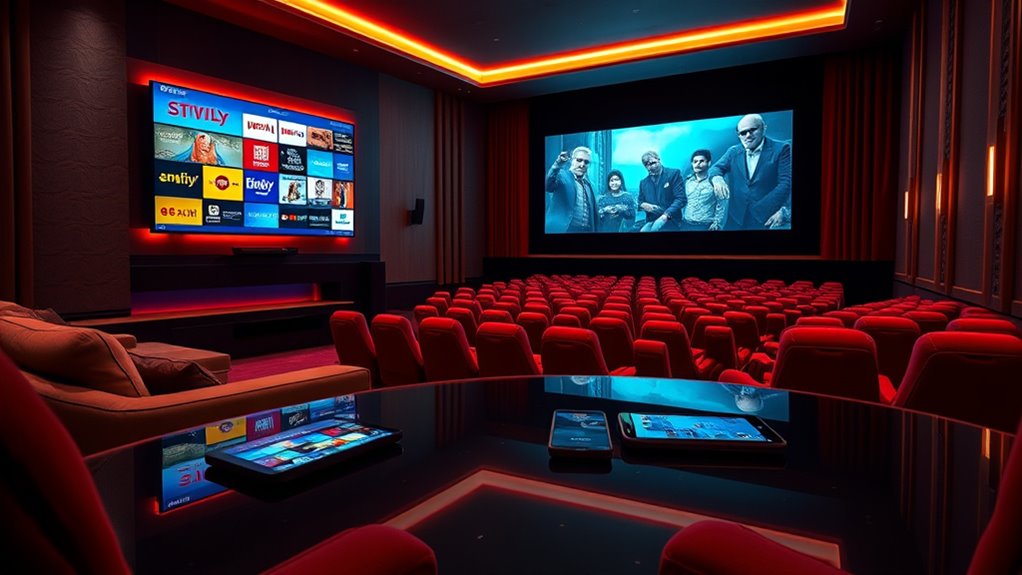
Integrating streaming and theatrical releases is reshaping how movies reach audiences, blending traditional and digital platforms to maximize impact. You might notice some films debut simultaneously in theaters and on OTT platforms, broadening their reach instantly. Exclusive content deals with streaming services attract viewers and generate buzz before the film hits cinemas. Theatrical releases are increasingly used as promotional tools, drawing attention to films before they move to streaming. The traditional windowing model—release in theaters first, then on OTT—is being reevaluated to suit new viewing habits. Collaborations between studios and streaming platforms are becoming more common, creating hybrid distribution strategies. This integrated approach helps filmmakers reach diverse audiences, adapt to changing consumer preferences, and balance revenue streams in a rapidly evolving industry.
How Content Quality and Diversity Are Redefining Success
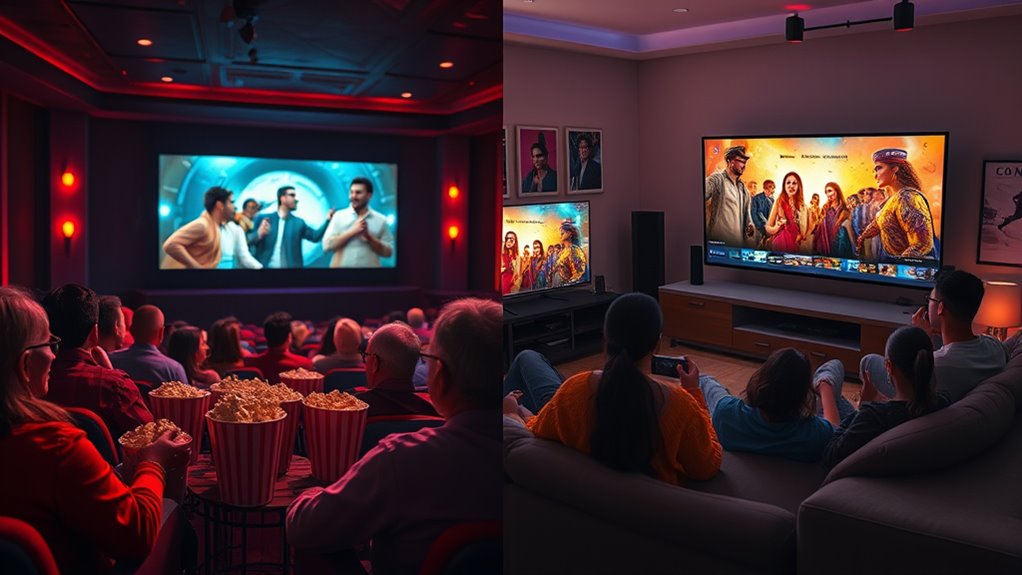
Have you noticed how the focus on content quality and diversity is transforming what success means in streaming and cinema? Streaming platforms now prioritize creating high-quality, innovative content to attract and retain viewers across diverse tastes. They’re investing in regional languages and niche genres, broadening the variety of stories told. This shift encourages experimentation, pushing creators to develop fresh, compelling narratives that stand out. However, the industry’s consolidation means fewer films are produced, narrowing choices in theaters and on platforms. As a result, success isn’t just about box office numbers anymore; it’s about engaging audiences with diverse, well-crafted content that resonates globally. This new focus is redefining what it takes to succeed in today’s entertainment landscape.
Challenges and Opportunities for Bollywood in the Streaming Era

Bollywood faces significant challenges in the streaming era as traditional box office revenues decline and audience preferences shift toward home viewing. The drop in box office collections, with Hindi films falling 13% in 2024, shows the changing landscape. Meanwhile, OTT deals are shrinking, with a 20-30% cut in releases, and Hindi films’ market share has decreased from 45% in 2015 to 40% in 2024. Content is moving to streaming platforms, raising concerns over diversity and market control. You should also note:
- Dominance of streaming giants like Netflix and Amazon
- Reduced theatre attendance and regional film rise
- Limited theatrical releases impacting footfall
- New revenue opportunities and global exposure through streaming
Despite these hurdles, streaming offers Bollywood opportunities for diversification, international reach, and niche content creation.
Frequently Asked Questions
How Are OTT Platforms Influencing Bollywood’S Traditional Revenue Models?
You see that OTT platforms are transforming Bollywood’s traditional revenue models by cutting into box office earnings and making film acquisition costs lower. They’re changing how films generate income, with digital rights becoming a major revenue source. You also notice how OTT’s popularity prompts filmmakers to focus on content for digital audiences, leading to a shift in investment, production strategies, and a reevaluation of how movies make money.
What Strategies Do Filmmakers Use to Balance Theatrical and OTT Releases?
You’re caught between a rock and a hard place, balancing theatrical and OTT releases. To succeed, you plan dual release dates, often with short windows, ensuring both audiences get their turn. You also negotiate flexible contracts, adapt marketing strategies, and analyze data to make informed decisions. When conflicts arise, court mediation helps you find common ground, safeguarding your film’s reach while protecting your reputation in this ever-evolving landscape.
How Does Audience Engagement Differ Between Cinema and Streaming Platforms?
You notice that audience engagement varies between cinema and streaming platforms. In cinemas, you experience a communal, immersive environment that heightens emotional impact during blockbuster releases. On streaming, you enjoy convenience, personalized choices, and the ability to binge-watch, which deepens your engagement over time. While cinemas foster shared cultural moments, streaming allows you to explore diverse content at your own pace, shaping your overall viewing experience.
What Are the Long-Term Impacts of OTT on Bollywood’S Creative Diversity?
Imagine a garden where new seeds sprout in unexpected places—that’s how OTT impacts Bollywood’s creative diversity long-term. You’ll see more regional stories, experimental narratives, and fresh talent flourish, breaking traditional molds. This vibrant landscape invites innovation, allowing filmmakers to explore bold ideas without the constraints of mainstream cinema. Over time, it nurtures a richer, more inclusive Bollywood, reflecting India’s multifaceted culture and expanding its global creative footprint.
How Are Regional and International Content Shaping Bollywood’S Future Trends?
Regional and international content are markedly shaping Bollywood’s future trends. You’ll notice more diverse storytelling, cultural exchange, and talent integration from regional films, making Bollywood more inclusive. International collaborations introduce new techniques and narratives, boosting global appeal. OTT platforms facilitate this by offering easy access, encouraging innovation, and enabling niche targeting. As a result, Bollywood evolves with richer stories, broader audiences, and increased global recognition, driven by the influence of regional and international content.
Conclusion
As streaming platforms reshape Bollywood like a river carving new paths, you’ll find the industry evolving beyond traditional box offices. Embracing OTT means adapting to fresh audience tastes and diverse content, turning challenges into opportunities. By blending theatrical releases with digital innovation, Bollywood can thrive in this dynamic era. Just as a river finds new courses, your favorite stories will continue to flow, vibrant and limitless, into the future of entertainment.
